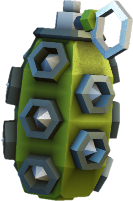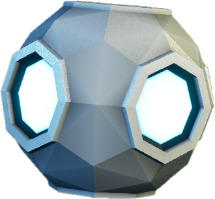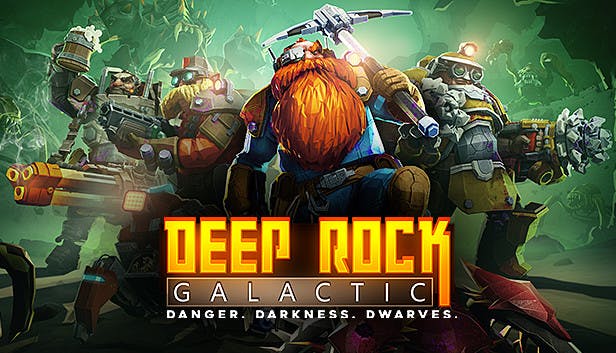This guide goes through each of the grenades available to each class in Deep Rock Galactic and shows how they can be effectively utilized on Hoxxes. This guide is not satirical.
Grenade Basics
Grenades- also referred to as “Throwables”- are one of the different types of tools available for a Dwarf to use when fightng through the unending hospitality of Hoxxes’ wildlife. Grenades can be thrown using the [G] key on a keyboard or the [?] button on controllers.
Each Dwarf class has three different unlockable types of grenades at their disposal, but can only bring one type down to Hoxxes at a time. Grenades can be set per loadout, allowing them to compliment any playstyle in a myriad of different ways, depending on the type of grenade equipped. Each class generally has 4 grenades at their disposal (except for certain grenade types) and can collect more from a Resupply Pod if their supply is depleted. Knowing the effective deployment strategies for each grenade is key to using them to maximum effect against bugs and, and this is a big factor, to absolute minimum effect against your fellow Dwarves.
Driller’s Grenades
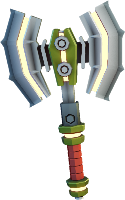
The Impact Axe is the first “grenade” that the Driller can use. When thrown, it extends into its full size and deals immense direct damage to a single target on direct impact. Additionally, it also releases an electric pulse on impact, which damages nearby enemies as well to a lesser extent. If the Impact Axe misses its target and gets lodged in the terrain, the Driller can simply interact with it to pick it back up, adding it back into their inventory for reuse. The Impact Axe is especially useful for the Driller, whose other weapons typically fall very short in terms of single-target suppression. When used against Glyphid Praetorians, for example, you can disrupt its Acid Spray attack with a single hit from the Impact Axe due to the Stun factor included in the direct damage dealt. You can deal even more damage to it by tossing an Axe at its glowing thorax on its rear flank, exploiting its weakpoint damage bonus for even higher damage dealt.
This strategy applies to any creature’s weakspots, but be wary of creatures with unbreakable armor, such as the Glyphid Oppressor, whose armor can shrug off the Impact Axe with ease. Also, you will want to learn how to properly lead smaller, faster, and/or farther targets when using the Impact Axe against them for maximum accuracy. The Impact Axe is also not recommended to use against Macteras, as they can easily slide out of the way of the axe while in the air.
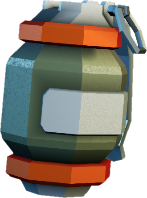
The High Explosive Grenade is the second grenade available for the Driller to use once unlocked. This is a more generic grenade and the only one of its kind in the game. It explodes a few seconds after being thrown, dealing moderate damage to anything caught in its blast radius. It can also be used for destroying terrain if needed, similarly to the Driller’s Satchel Charges. Players may find this type of grenade somewhat underwhelming, especially compared to the other grenades available in the game, but its unspecialized function means that it can fit into almost any situation when no other grenades fit the bill in a given loadout.
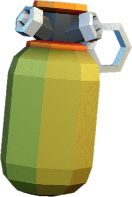
The Neurotoxin Grenade is an intriguing grenade available to the Driller once unlocked. Before this grenade is discussed, it may be worth mentioning another tactic the Driller can use. When a Glyphid Praetorian or Oppressor dies, it emits a cloud of toxic green gas that can harm Dwarves within it over time. The Driller can use this to their advantage when their Flamethrower by shooting the gas cloud with it; this ignites the gas and creates a moderate fiery explosion, dealing damage to both bugs and Dwarves in the area, before clearing the gas cloud entirely. The Neurotoxin Grenade works based on a very similar principle, except the gas covers a much larger area and is an engineered neurotoxin compound, which can deal heavy damage over time to bugs,
but doesn’t harm Dwarves at all. The neurotoxin cloud can also be ignited if necessary, dealing damage to any bugs or Dwarves near it, similarly to the green gas clouds mentioned earlier.
The Neurotoxin Grenade is a very effective area-denial and crowd-control tool and excels in defensive postures. For example, in Salvage Operation missions, the Driller can toss a Neurotoxin Grenade at the base of the Uplink or Fuel Cell Dispenser to create a massive hazard to any incoming bugs. Alternatively, in Escort Duty missions, the Driller can toss one of these grenades out behind the Drilldozer while it’s moving to suppress incoming bugs for a long period of time. In either case, the neurotoxin clouds can still be ignited if the need arises to deal massive damage to enemies within the cloud, but just make sure that no Dwarves are fighting inside the cloud before doing this.
NOTE: The Driller’s Satchel Charges are not counted as Grenades (they are the Driller’s Support tool), despite being deployed in a similar fashion. As such, they will not be discussed in this article.
Engineer’s Grenades
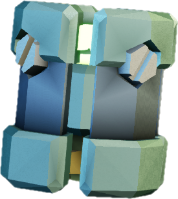
The L.U.R.E. (Laser Utility Refractive Emitter) is a crowd-control-oriented grenade, and the first grenade the Engineer can use. After being tossed, the L.U.R.E. waits until it comes to a standstill on the ground before displaying an obnoxious hologram of a Dwarf dancing. It’s so annoying to look at that most bugs in the area will divert away from actual Dwarves and attack the hologram instead. It has its own “health” integrity, represented by the color of the hologram; once depleted, the L.U.R.E. emits a large electric pulse, electrocuting all nearby bugs upon its destruction.
This grenade is a very useful support tool for dealing with large swarms, as it can cluster up large groups of bugs into a single area for an extended time period. This can be used to make a quick getaway from a Swarm of bugs when you’re alone in an area, but it can also open up opportunities for Dwarves with explosive weapons to destroy a lot of bugs at once, such as the Engineer’s grenade launcher, the Gunner’s autocannon, or even other grenades!
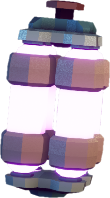
The Plasma Burster is a much more specialized grenade available to the Engineer once unlocked. Once the grenade hits a target or the ground, it releases four bursts of searing plasma in quick succession, all propagating directly from the grenade itself. The Plasma Burster is used a lot like the Impact Axe, being designed for semi-focused damage against a small amount of targets. It is recommended to toss this grenade at either a single target (ideally one up against a wall) or the front of a line of targets, such as a group of Glyphid Grunts on approach. The Plasma Burster has a slight learning curve to it, but can be very useful when deployed properly. Practice is key!
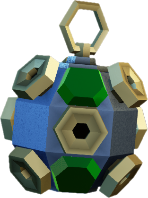
The Proximity Mine is the Engineer’s third unlockable grenade, and arguably the most commonly misused grenade of them all. Proximity Mines stick to the terrain they land on, arm after a few seconds, and detonate up to four times once a bug wanders into its proximity, denoted by a yellow pulse propagating from the Mine itself. Additionally, if a Mine is misplaced, it can be safely disarmed by interacting with it, which returns the Mine to your inventory, similarly to the Impact Axes. Proximity Mines also don’t expire until they’ve detonated their last charge, so they can work well for long-term defensive strategies.
The trick to using Proximity Mines effectively is to be conscientious in regards to their placement. The Mines can damage Dwarves is they’re near one when it detonates, so it is crucial to place your Mines a fair distance away from where your teammates will be, especially when playing defensive missions like Escort Duty and Salvage Operation. It’s also very impractical to place multiple Mines in close proximity to each other, as this often wastes the charges on your Mines by forcing them to detonate after a detected target is killed. Your best bet is to place Proximity Mines within narrow chokepoints, such as narrow tunnels, that bugs will be forced to move through to reach you and/or your teammates. Additionally, if you see a group of bugs coming at you from afar, with practice you can anticipate their path and place a mine down where they will be coming at you from, softening up their numbers and/or strength while they make their approach. No matter how you use the Proximity Mines, though, you need to be very careful to place them so that they have a minimal risk of harming your fellow Dwarves.
Gunner’s Grenades
The Sticky Grenade is the first grenade available for the Gunner to use. It functions very similarly to the Driller’s HE Grenade, except the Gunner’s grenade sticks to whatever it hits, be it the terrain or a bug, before exploding. This makes it very useful for more precise grenade throws and eliminating clumped-up groups of enemies. This makes it pair very well with the Engineer’s L.U.R.E. for neutralizing tight clumps of targets all at once.

The Incendiary Grenade is the second grenade that the Gunner can unlock. It Upon impacting the terrain, it coats a large area in sticky flames, similarly to the flames produced by the Driller’s Flamethrower, which can damage any enemies that walk over them. This weapon works very well for softening up approaching bugs; toss it at or in front of a clump of enemies and let the harsh flames work their magic. Where the Incendiary Grenade really shines, though, is in its sheer capability against Swarmers. Any Swarmers charging through the grenade’s sticky flames will die almost instantly, allowing Dwarves to focus on larger enemies instead. By extension, this makes the Incendiary Grenade an excellent tool for dealing with Swarmer Tunnels in caves as well; break off a chunk of the Tunnel with your pickaxe and toss a grenade at the Tunnel to easily kill off those Swarmers before they can get far.

The Cluster Grenade is a very indiscriminate grenade designed with crowd control in mind and with absolutely zero regard to collateral damage. The Cluster Grenade splits into nine submunitions shortly after being tossed, which disperse randomly around a wide cone towards the ground and detonate upon impact. The unfocused damage of the grenade works exceptionally well for crowd control, especially against very large hoards of incoming Grunts or the like. The Cluster Grenade is also very well-known for its uncanny teamkilling capabilities, so be very careful not to toss it anywhere near your fellow Dwarves.
Scout’s Grenades
The Inhibitor-Field Generator (IFG) is the first grenade available for the Scout to use. It activates shortly after being thrown, creating a large energy field which slows down any bugs (but not Dwarves) that wander into it. This grenade is most useful in narrow chokepoints, where it can slow down large swaths of enemies to give other Dwarves more time to hit their targets or cover a hasty retreat. The IFG slows down any bugs that get caught in its field, which can make it a useful tool for taking out Dreadnoughts by preventing them from turning and keeping their weakpoints exposed for suppressing fire. Additionally, because it doesn’t affect Dwarves, it can be easily tossed at one’s feet to give players more time to take down incoming enemies before they can get ganged-up on.
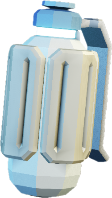
The Cryo Grenade is the second unlockable grenade for the Scout. It detonates shortly after it’s tossed, flash-freezing all bugs within its area of effect. Frozen enemies take 3x damage from all sources (but weakpoint damage bonuses do not apply to frozen enemies), which makes the Cryo Grenade an excellent fire support tool against incoming hoards of enemies. Additionally, like with the IFG, the Cryo Grenade can also be used to slow down advancing hoards of enemies. Just make sure you aren’t tossing the grenades near Dwarves, though, as they could get caught up in the flash-freeze as well.

The Pheromone Canister is a curious grenade available for the Scout to unlock. When tossed at a tightly-packed group of enemies, it covers them in a rancid bile that drives them crazy and makes them start attacking each other. Additionally, any enemies not affected by the pheromone bile will openly attack any bugs covered in it and vice-versa. This creates utter chaos among hoards of bugs and opens them up to covering fire while keeping them in a single place, like with the Cryo Grenade and the IFG. It can also be used to clog up a chokepoint for retreating or providing covering fire.






